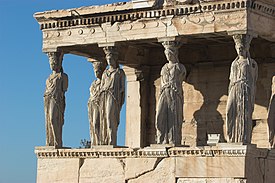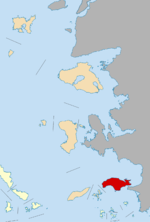A phratra of Spartan soldiers, 27 in all, gave chase.
The Spartan army stood at the centre of the Spartan state, whose citizens' primary obligation was to be good soldiers. Subject to military drill from infancy, the Spartans were one of the most feared military forces in world history. At Sparta's heyday in the 6th to 4th centuries BC, it was commonly accepted that "one Spartan was worth several men of any other state."Hall of a Hundred Columns
Tactical structure
The principal source for the organization of the Spartan Army is Xenophon, who admired the Spartans and whose Constitution of Sparta offers a detailed overview of the Spartan state and society at the beginning of the 4th century BC. Other authors, notably Thucydides, also provide information, but it is not always as reliable as Xenophon's first-hand accounts. Spartan armour helmet.
Spartan armour helmet.
Little is known of the earlier organization, and much is left open to speculation. The earliest form of social and military organization (during the 7th century BC) seems to have been the three tribes (phylai: the Pamphyloi, Hylleis and Dymanes) who appear in the Second Messenian War (685-668 BC). A further subdivision was the "fraternity" (phratra), of which 27, or nine per tribe, are recorded. Eventually this system was replaced by five territorial divisions, the obai ("villages"), which supplied a lochos of ca. 1,000 men each. This system was still used during the Persian Wars, as implied by references to the lochoi made by Herodotus in his history.
The changes that occurred between the Persian and the Peloponnesian Wars are not documented, but according to Thucydides, at Mantinea in 418 BC there were 7 lochoi present, each subdivided into four pentekostyes of 128 and 16 enōmotiai of 32 men, giving a total of 3584 men for the main Spartan army. By the end of the Peloponnesian War, the structure had evolved further, both to address the shortages in manpower and to create a more flexible system that allowed the Spartans to send smaller detachments on campaign or to garrisons outside their homeland.
According to Xenophon, the basic Spartan unit remained the enōmotia, with 36 men in three files of twelve under an enōmotarches. Two enōmotiai formed a pentēkostys of 72 men under a pentēkontēr, and two pentēkostyai were grouped into a lochos of 144 men under a lochagos. Four lochoi formed a mora of 576 men under a polemarchos, the largest single tactical unit of the Spartan army. Six morai composed the Spartan army on campaign, to which were added the Skiritai and the contingents of allied states.
Persepolis was the ceremonial capital of the Achaemenid Empire (ca. 550–330 BCE). Persepolis is situated 70 km northeast of the modern city of Shiraz in the Fars Province of modern Iran. The earliest remains of Persepolis date from around 515 BCE.William Turner, born in Morpeth in 1508. Considered by manty to be thefather of english botany.
UNESCO declared the citadel of Persepolis a World Heritage Site in 1979
The Throne Hall
Next to the Apadana, second largest building of the Terrace and the final edifices, is the Throne Hall or the Imperial Army's hall of honour (also called the "Hundred-Columns Palace). This 70x70 square metre hall was started by Xerxes and completed by his son Artaxerxes I by the end of the fifth century BC. Its eight stone doorways are decorated on the south and north with reliefs of throne scenes and on the east and west with scenes depicting the king in combat with monsters. Two colossal stone bulls flank the northern portico. The head of one of the bulls now resides in the Oriental Institute in Chicago.
In the beginning of Xerxes's reign, the Throne Hall was used mainly for receptions for military commanders and representatives of all the subject nations of the empire. Later the Throne Hall served as an imperial museum.
William Turner MA (?1508 – 13 July 1568) was an English divine and reformer, a physician and a natural historian. He studied medicine in Italy, and was a friend of the great Swiss naturalist, Conrad Gessner. He was an early herbalist and ornithologist, and it is in these fields that the most interest lies today
Early years
William Turner was born in Morpeth, Northumberland in or around 1508. His father was probably a tanner of the same name. He studied at Pembroke Hall, Cambridge University from 1526 to 1533, where he received his B.A. in 1530 and his M.A. in 1533.[3] He was a Fellow and Senior Treasurer of Pembroke Hall, Cambridge. While at Cambridge he published several works, including Libellus de re herbaria, in 1538. He spent much of his leisure in the careful study of plants which he sought for in their native habitat, and described with an accuracy hitherto unknown in England.
In 1540, he began traveling about preaching until he was arrested. After his release, he went on to study medicine in Italy, at Ferrara and Bologna, from 1540 to 1542 and was incorporated M.D. at one of these universities.
Career
After completing his medical degree, he became physician to the Earl of Emden. Back in England he became Chaplain and physician to the Duke of Somerset, and through Somerset's influence he obtained ecclesiastical preferment. The position as Somerset's physician also led to practice among upper society. He was prebendary of Botevant in York Cathedral in 1550, and Dean of Wells Cathedral from 1551 to 1553, where he established a Herbal garden.[4] When Mary I of England acceded to the throne, Turner went into exile once again. From 1553 to 1558, he lived in Weißenburg in Bayern and supported himself as a physician. He became a Calvinist at this time, if not before.
After the succession of Elizabeth I of England in 1558, Turner returned to England, and was once again Dean of Wells Cathedral from 1560 to 1564. His attempts to bring the English church into agreement with the reformed churches of Germany and Switzerland led to his suspension for nonconformity in 1564. Turner died in London on 7 July 1568 at his home in Crutched Friars, in the City of London, and is buried in the church of St Olave Hart Street. An engraved stone on the south-east wall of this church commemorates Turner. Thomas Lever, one of the great puritan preachers of the period, delivered the sermon at his funeral.
Quite early in his career, Turner became interested in natural history and set out to produce reliable lists of English plants and animals, which he published as Libellus de re herbaria in 1538. In 1544, Turner published Avium praecipuarum, quarum apud Plinium et Aristotelem mentio est, brevis et succincta historia, which not only discussed the principal birds and bird names mentioned by Aristotle and Pliny the Elder but also added accurate descriptions and life histories of birds from his own extensive ornithological knowledge. This is the first printed book devoted entirely to birds.
In 1545, Turner published The Rescuynge of the Romishe Fox, and in 1548, The Names of Herbes. In 1551, he published the first of three parts of his famous Herbal, on which his botanical fame rests.
A new herball, wherin are conteyned the names of herbes… (London: imprinted by Steven Myerdman and soolde by John Gybken, 1551) is the first part of Turner's great work; the second was published in 1562 and the third in 1568, both by Arnold Birckman of Cologne. These volumes gave the first clear, systematic survey of English plants, and with their admirable woodcuts (mainly copied from Leonhart Fuchs's 1542 De historia Stirpium) and detailed observations based on Turner's own field studies put the herbal on an altogether higher footing than in earlier works. At the same time, however, Turner included an account of their "uses and vertues", and in his preface admits that some will accuse him of divulging to the general public what should have been reserved for a professional audience. For the first time, a herbal was available in England in the vernacular, from which people could identify the main English plants without difficulty.
A New Book of Spiritual Physick was published in 1555. In 1562, Turner published the second part of his Herbal, dedicated to Sir Thomas Wentworth, son of the patron who had enabled him to go to Cambridge. This book was published by Arnold Birckman of Cologne, and included in the same binding Turner's treatise on baths. The third and last part of Turner's Herbal was published in 1568, in a volume that also contained revised editions of the first and second parts. This was dedicated to Queen Elizabeth. A New Boke on the Natures and Properties of all Wines, also published in 1568, had pharmacological intent behind it, as also the included Treatise of Triacle.
Natural history publications
- 1538: Libellus de re herbaria novus. Bydell, London. Index 1878; facsimiles 1877, 1966.
- 1544: Avium praecipuarum, quarum Plinium et Aristotelum mentio est, brevis et succincta historia. Gymnicus, Cologne. ed Cambridge 1823; ed with transl. Cambridge 1903.
- [1548]: The names of herbes. Day & Seres, London. ed 1881; facsimile 1966.
- 1551: A new herball. pt 1 Mierdman, London; pt 2 Barckman, Cologne. 1568, Cologne: part 2 in parts.








